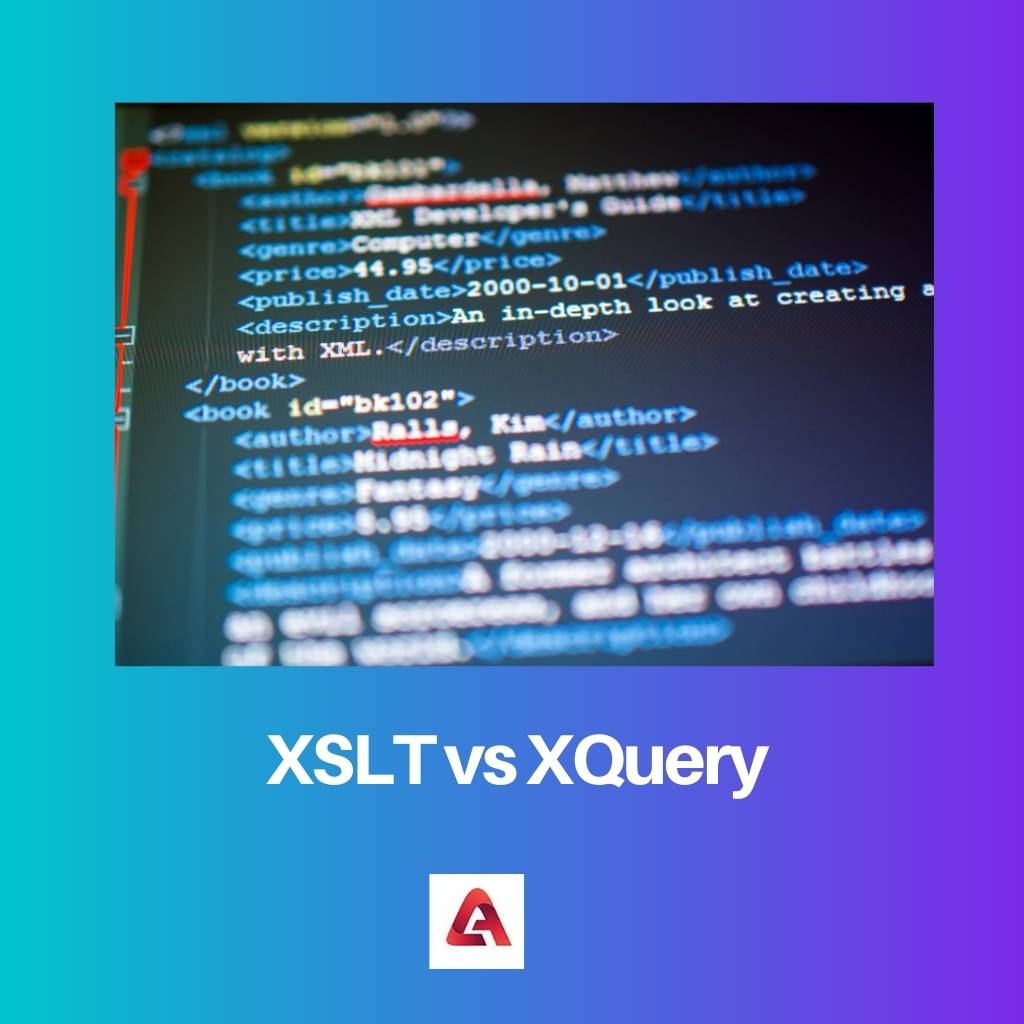XSLT and XQuery are two programming languages that involve handling XML documents and their databases, and what is common among them is that both use the syntax Xpath.
But in spite of this fact, these two languages are completely functionally exclusive and unique and also have various other major differences.
Key Takeaways
- XSLT transforms XML documents into different formats, while XQuery is used for querying XML documents.
- XSLT can be used for simple and complex transformations, while XQuery is primarily used for complex transformations.
- XSLT is a declarative language, while XQuery is a functional programming language.
XSLT vs XQuery
XSLT (Extensible Stylesheet Language Transformations) is primarily used for transforming XML documents into different formats, such as HTML or PDF. XQuery is used for querying and extracting data from XML documents, allowing users to filter and extract specific data based on specific criteria.

XSLT is expanded as eXtensible Stylesheet Language – Transformation. As mentioned before, based on the instructions specified in an XSLT stylesheet, XSLT transforms an XML document. This ensures that the outputs in various possible formats can be obtained from a single source of a document or a set of those documents.
XQuery is yet another language specialization that can be found in the World Wide Web Consortium (W3C). XQuery has a significant utilization, and it is a query language for XML documents. Comparatively, while XSLT was designed basically for document rendition, data transformation is also a complementary function of the XSLT. Comparatively, XQuery was designed as one for querying XML databases.
Comparison Table
| Parameters of Comparison | XSLT | XQuery |
|---|---|---|
| Where is the code written? | It is written in XML | It is not written in XML |
| Type of language | XSLT in its functionality is a document-driven language | XQuery in its functionality is a program-driven language |
| Retrieving results | Results retrieved in tree structures | This is not used to retrieve results in tree structures |
| Function of language | Used to transform/change XML document | Used to easily access the XML document |
| Manageability | It may be difficult to maintain unless a carefully designed stylesheet is made by the user and is used | It is shorter, faster, and more manageable for huge data jobs. |
What is XSLT?
e-Xtensible Stylesheet Language Transformation is also referred to as XSLT in a working short term. It is a programming language that is structured for accessing tree structures.
Majorly, the XSLT language’s function is to transform XML data from one format to another automatically. That means if we apply XSLT to an XML document, we will get another XML document, HTML, etc.
XSLT can transform an XML document only in accordance with the instructions that we specify in an XSLT stylesheet. This results in several possible output formats from a single source or set of source documents, as mentioned above.
Its codes are written inside the XML document. So it can be said that an XSLT document and XML documents are similar.
Primarily, The design of the language was for writing stylesheets. These stylesheets can then enable the XML documents to be displayed to the ones reading them.
Hence, writing more than one style sheet can enable displaying the same information to different readers in a varied number of ways.
This also modifies the presentation to become eligible to be viewed on different display devices, which include web browsers, print media, and digital television.
Even though XSLT was originally designed as a specialized language for the purpose of XML transformation, since the language is Turing-complete, theoretically, the XSLT can possibly do any arbitrary computations.
What is XQuery?
Designed by W3C, XQuery was out for use for the first time in 2007. It is the language that finds its main use in querying XML data. Its main function is to access information that is stored in the XML format.
It is used for retrieving the information from a database that can then be used in various Web services like SoapUI, and functions to retrieve data from the database that is to be utilized in the integration of applications, to generate summary reports, and to retrieve relevant information from XML files.
XQuery was designed as a language for querying XML databases, similarly to SQL is used for querying relational databases.
Some examples of data retrieving from XML documents using XQuery are:
- Shows all the books that are published by Penguin
- What is the average price of books with ‘Dan Brown’ in the title? Etc.
Also to mention, similar to the language XSLT, XQuery can also be used to transform XML data from one format to another, but the language is inferior to XSLT.
Elsewhere, various usability studies have promptly proven that it is simpler for users to learn and customize themselves with the XQuery language compared to XSLT because the learning curve is significantly more flat.
Main Differences Between XSLT and XQuery
- XQuery language is program-driven, and XSLT language is document-driven.
- XSLT code is written in XML, while XQuery code is not written in XML.
- XQuery is non-frequently used for transformations, while XSLT is a language that was specially designed to perform these things and process tree structures.
- XQuery is much less sophisticated and powerful than XSLT, which is still considered to be the best to retrieve results in the tree structure.
- XQuery is efficient in accessing the XML database and retrieving the necessary XML nodes, but XSLT is incapable of doing the same.
- XQuery is designed for querying a broad spectrum of XML information sources, like XML databases and XML documents. Comparatively, XSLT is designed essentially for transforming the XML documents.
- XQuery is considered easily learnable and more manageable, while XSLT is considered comparatively difficult.





